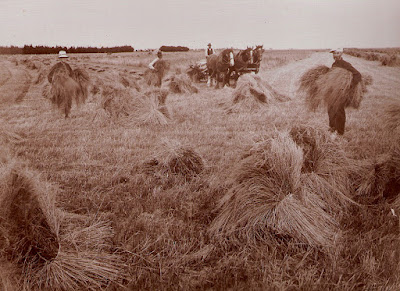This is the sixth part of my gallery celebrating Scottish stately homes and castles. The images in this gallery were taken during the Edwardian period and are from my own family collection. I have attempted to provide a history of each home or castle however the fact that many such old homes are in ruinous, vacant or no longer exist is to be regretted. The loss of any historic building is indeed unfortunate so this gallery also serves as a celebration of this lost heritage and the various families over the centuries who built and owned these fascinating properties.
 |
| Cambusnethan House [Castle], Wishaw, pre 1906. |
Cambusnethan House (also known as Cambusnethan Castle or Priory) at Wishaw was built by the Architect James Gillespie Graham and completed in 1820, replacing an earlier 17th century manor house which burnt down in 1810. A Norman tower house had also occupied a site nearby. Cambusnethan House was built for the Lockhart family whose crest appeared above the main entrance and etched in every balustrade of the main staircase inside. The crest represents a casket, heart and lock and derives from the tradition that the ancestors of this family carried Robert the Bruce's heart back from the holy land.
The house is two and three storeys high with turrets at each corner, a three-storey bow in the west elevation and a massive square porch. Characteristically, the house was very ornately decorated with a variety of architectural details; castellated roof lines, scrolled pinnacles, narrow pointed windows and drip moulds, and various cornices, besides carved motifs and decorated chimneys. Some of the ornate pinnacles have now been removed in the interest of safety.
Cambusnethan House was saved from demolition by being privately purchased in 1967. From 1973 it served as a hotel and restaurant before closing in 1984 due to bankruptcy. It has since been vacant, the interior stripped, falling prey to vandalism, and after a major fire in 1985 is now roofless and in a deplorable condition. The west section of the south elevation has now collapsed. It does however appear that objections to and refusal of planning permission for a new development on the grounds including the house has seriously hindered any chance of saving the building. Cambusnethan House is generally regarded as being the best remaining example of a Graham-built country house in the quasi-ecclesiastical style of the Gothic revival. The sad demise of this attractive building is to be regretted.
 |
| The Ross, Motherwell, pre 1905 |
The Ross at is a very large "B" grade listed baronial mansion situated in parkland between Motherwell and Hamilton. The core is formed by a building dating from 1783. In 1889, the owner, Colonel H H Robertson Aikman, commissioned the Architect Alexander Cullen to reconstruct The Ross in the Scottish Baronial Style perfected by David Bryce. Cullen's plans were widely published as well as being exhibited at the Royal Scottish Academy and the Royal Glasgow Institute of the Fine Arts, thus firmly establishing his reputation.
Situated within spacious grounds the house includes "a garden front with 6-storey cornertower to left, advanced bay to right with bartizans [projecting turrets] and 1st floor oriel [projecting bay window], elaborate Craigievar string coursing [a thin projecting course of stone running horizontally around a building] with canon spouts, gabled dormers, strapwork [decorative motis in relief] and pediment overthrows to mullioned windows, half columned porch with catilevered balcony to left. Enclosed service courtyard with tower." [Source : British Listed Buildings]
The property is well maintained, having the good fortune to have remained in the ownership of descendants of the Aikman family, the present owner being Mr Robert John Graham-Campbell. You can read some interesting information about the family and view some period images of The Ross HERE.
Bibliography :
- Various Internet sources
- All images are from my own collection and may be freely copied provided a link is given back to this page.
Situated within spacious grounds the house includes "a garden front with 6-storey cornertower to left, advanced bay to right with bartizans [projecting turrets] and 1st floor oriel [projecting bay window], elaborate Craigievar string coursing [a thin projecting course of stone running horizontally around a building] with canon spouts, gabled dormers, strapwork [decorative motis in relief] and pediment overthrows to mullioned windows, half columned porch with catilevered balcony to left. Enclosed service courtyard with tower." [Source : British Listed Buildings]
The property is well maintained, having the good fortune to have remained in the ownership of descendants of the Aikman family, the present owner being Mr Robert John Graham-Campbell. You can read some interesting information about the family and view some period images of The Ross HERE.
Bibliography :
- Various Internet sources
- All images are from my own collection and may be freely copied provided a link is given back to this page.
















